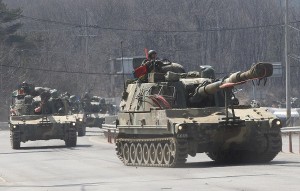
South Korean army K-55 self-propelled howitzers move during an exercise against possible attacks by North Korea in Pocheon, South Korea, near the border with North Korea, Wednesday, March 27, 2013. AP FILE PHOTO
SEOUL, South Korea — Raising tensions with South Korea yet again, North Korea said it cut the last military hotline with Seoul because there was no need for communications between the countries in a situation “where a war may break out at any moment.”
The hotline had provided a channel of communications between the militaries of North Korea and South Korea, which do not have diplomatic relations. The Korean Peninsula remains in a technical state of war, divided by a heavily guarded border and with both governments prohibiting direct contact with citizens on the other side.
However, for nearly a decade, the main use of the military hotline was to arrange passage for South Korean managers who work at a joint industrial complex in the North through the Demilitarized Zone. In 2009, North Korea’s move to sever the phone connection stranded some South Korean workers in the North for several days.
The move Wednesday to shut down one of the only modes of communication between the Koreas is the latest of a series of threats designed to provoke the new government in Seoul to change its policies toward neighboring North Korea. President Park Geun-hye took office in Seoul a month ago.
Moves at home to order North Korean troops into “combat readiness” also are seen as ways to build domestic unity as young leader Kim Jong Un strengthens his military credentials.
North Korea’s chief delegate to inter-Korean military talks relayed in a message Wednesday to his South Korean counterpart that Pyongyang would sever communications until South Korea halts “hostile acts” against the neighbor.
South Korea and the U.S. have been holding routine joint military drills that Pyongyang considers rehearsals for invasion. North Korea also accuses the South of joining the U.S. in leading the campaign to punish Pyongyang for conducting a long-range rocket launch in December and an underground nuclear test in February.
“Under the situation where a war may break out any moment, there is no need to keep North-South military communications,” he said. “North-South military communications will be cut off.”
Seoul’s Unification Ministry, which is in charge of relations with the North, called it an “unhelpful measure for the safe operation of the Kaesong complex.”
North Korea recently also cut a Red Cross hotline with South Korea and another with the U.S.-led U.N. command at the border between the Koreas. However, three other telephone hotlines used for exchanging information about air traffic remain intact.
The line severed Wednesday has been essential in operating the last major symbol of inter-Korean cooperation from the 2000s: an industrial complex in the North managed by hundreds of workers from the South. The phone line is used to clear cross-border shipments and to arrange passage for South Koreans who commute to Kaesong.
Aside from the hotlines, there are no landline, cellphone, fax, email or mail connections between North and South Korea. Both Seoul and Pyongyang prohibit from direct contact with citizens from the other Korea without government permission.
There was no immediate word about the impact on South Korean workers who were at the Kaesong industrial complex. About 750 South Koreans were working in Kaesong on Wednesday, officials said, and that the two Koreas had normal communications earlier in the day over the hotline when South Korean workers traveled back and forth to the factory park as scheduled.
South Korean managers working in the border town could also be contacted on their South Korean cellphones from Seoul on Wednesday.
A South Korean worker for Pyxis, a company that produces jewelry cases at Kaesong, said in a phone interview that he was worried about a possible delay in production if cross-border travel is banned again.
“That would make it hard for us to bring in materials and ship out new products,” said the worker, who wouldn’t provide his name because of company rules.
The worker, who has been in Kaesong since Monday, said he wasn’t scared.
“It’s all right. I’ve worked and lived with tension here for eight years now. I’m used to it,” he said.
Since 2004, the Kaesong factories have operated with South Korean money and know-how, with North Korean factory workers managed by South Koreans. The factories provide jobs and bring in much-needed hard currency for North Korea, and supply a cheap and efficient labor source for South Korea.
Other examples of joint inter-Korean cooperation that blossomed during an earlier era of detente came and went during the previous administration of South Korean President Lee Myung-bak, whose tough policies on North Korea angered the Pyongyang regime.
North Korea also cut the Kaesong line in 2009, in a protest of that year’s South Korean-U.S. military drills. North Korea refused several times to let South Korean workers return home from their jobs, leaving hundreds stranded in North Korea. The country restored the hotline and reopened the border crossing more than a week later, after the drills ended.
North Korea’s actions have been accompanied by threatening rhetoric, including a vow to launch a nuclear strike against the United States and a repeat of its nearly two-decade-old threat to reduce Seoul to a “sea of fire.” However, analysts outside the country have seen no proof that the country has mastered the technology needed to build a nuclear warhead small enough to mount on a missile.
In a sign of heightened anxiety, Seoul briefly bolstered its anti-infiltration defense posture after a South Korean border guard hurled a hand grenade and opened fire at a moving object early Wednesday. South Korean troops later searched the area but found no signs of infiltration, and officials believe the guard may have seen a wild animal, according to Seoul’s Defense Ministry.